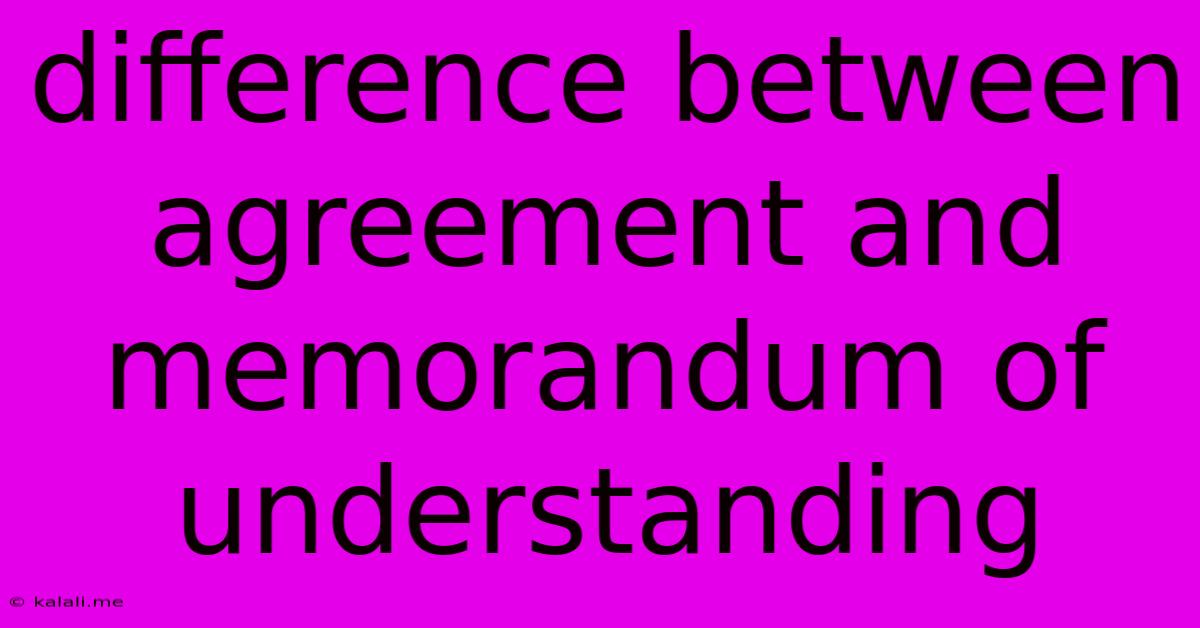Difference Between Agreement And Memorandum Of Understanding
Kalali
Jun 15, 2025 · 3 min read

Table of Contents
Agreement vs. Memorandum of Understanding (MOU): Key Differences and When to Use Each
Understanding the difference between an agreement and a memorandum of understanding (MOU) is crucial for businesses and individuals alike. While both documents represent an understanding between parties, their legal weight and enforceability differ significantly. This article will clarify the key distinctions, helping you choose the appropriate document for your situation.
Meta Description: Learn the key differences between a legally binding agreement and a non-binding memorandum of understanding (MOU). This guide explains when to use each document and clarifies their implications.
What is an Agreement?
An agreement is a legally binding contract that creates enforceable rights and obligations between parties. It's typically formal, detailed, and carefully drafted by legal professionals. Key elements include:
- Offer and Acceptance: A clear offer by one party and unconditional acceptance by another.
- Consideration: Something of value exchanged between the parties (e.g., money, goods, services).
- Intention to Create Legal Relations: A mutual understanding that the agreement is legally binding.
- Capacity to Contract: All parties must be legally competent to enter into a contract.
Breach of an agreement can lead to legal action, including damages or specific performance. Examples include sales contracts, employment contracts, and service level agreements (SLAs).
What is a Memorandum of Understanding (MOU)?
A memorandum of understanding (MOU), often referred to as a letter of intent, is a non-binding document outlining the common understanding and intentions of two or more parties. It's less formal than an agreement and generally lacks the detail found in a legally binding contract. Key characteristics include:
- Non-binding Nature: While it expresses the parties' intentions, it doesn't create legally enforceable obligations.
- Framework for Future Agreements: It serves as a stepping stone towards a more formal, legally binding agreement.
- Flexibility: It allows for greater flexibility in negotiations and adjustments as the relationship progresses.
- Record of Understanding: It provides a written record of the parties' agreed-upon principles and expectations.
Key Differences Summarized:
| Feature | Agreement | Memorandum of Understanding (MOU) |
|---|---|---|
| Legal Binding | Legally binding and enforceable | Non-binding, expresses intentions only |
| Formality | Formal, detailed, legally drafted | Less formal, less detailed |
| Enforceability | Breach leads to legal consequences | No legal recourse for breach |
| Purpose | Create legally enforceable obligations | Outline intentions, framework for future agreements |
| Specificity | Highly specific terms and conditions | General principles and expectations |
When to Use Each Document:
- Use an Agreement when: You need a legally enforceable contract to protect your interests and ensure compliance. This is essential for significant transactions involving money, property, or services.
- Use an MOU when: You want to express a common understanding, explore potential collaborations, or establish a framework for future negotiations without the immediate commitment of a legally binding contract. This is useful for early-stage partnerships, joint ventures, or complex negotiations.
Examples:
- Agreement: A contract for the purchase of a building, a software licensing agreement.
- MOU: An agreement between two universities to collaborate on research, a preliminary agreement between businesses exploring a merger.
Conclusion:
Choosing between an agreement and an MOU requires careful consideration of the context, the parties' relationship, and the level of risk involved. While an MOU can be a valuable tool for initial understanding, a legally binding agreement is crucial when enforceable commitments are needed. Seeking legal advice is recommended before signing any important document. Understanding the nuances between these two document types ensures your dealings are legally sound and strategically advantageous.
Latest Posts
Latest Posts
-
What Is Square Root Of 4096
Jun 15, 2025
-
How To Create A Joint Probability Table
Jun 15, 2025
-
What Organelles Contain Their Own Dna
Jun 15, 2025
-
Stevens Institute Of Technology Average Sat
Jun 15, 2025
-
Moment Of Inertia Of A T Section
Jun 15, 2025
Related Post
Thank you for visiting our website which covers about Difference Between Agreement And Memorandum Of Understanding . We hope the information provided has been useful to you. Feel free to contact us if you have any questions or need further assistance. See you next time and don't miss to bookmark.